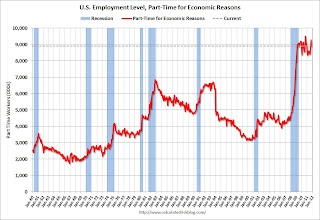by Calculated Risk on 11/04/2011 10:11:00 AM
Friday, November 04, 2011
Employment Summary, Part Time Workers, and Unemployed over 26 Weeks
This was a weak report, and the headline number was slightly below consensus forecasts. However some of the underlying data was a little more encouraging (with emphasis on "little").
There were only 80,000 jobs added in October. There were 104,000 private sector jobs added, and 24,000 government jobs lost.
However the change in total employment was revised up for August and September. "The change in total nonfarm payroll employment for August was revised from +57,000 to +104,000, and the change for September was revised from +103,000 to +158,000."
The household survey showed an increase of 277,000 jobs in October. This increase in the household survey pushed the unemployment rate down slightly, even as more people participated in the workforce (labor force increased by 181,000). The unemployment rate declined to 9.0%, and the participation rate was unchanged at 64.2%. The employment population ratio also increased to 58.4% from 58.3%. This is the third straight monthly increase in the employment population ratio from the low in July at 58.1%.
U-6, an alternate measure of labor underutilization that includes part time workers and marginally attached workers, declined to 16.2% - and this is very high. The low for the year was 15.7% in March, and the high was 16.5% in September. U-6 was in the 8% range in 2007.
The average workweek was unchanged at 34.3 hours, and average hourly earnings increased slightly. "The average workweek for all employees on private nonfarm payrolls was unchanged at 34.3 hours in October... In October, average hourly earnings for all employees on private nonfarm payrolls increased by 5 cents, or 0.2 percent, to $23.19. ... Over the past 12 months, average hourly earnings have increased by 1.8 percent." This is sluggish earnings growth, and earnings are being impacted by the large number of unemployed and marginally employed workers.
Through the first ten months of 2011, the economy has added 1.256 million total non-farm jobs or just 125 thousand per month. This is a better pace of payroll job creation than last year, but the economy still has 6.47 million fewer payroll jobs than at the beginning of the 2007 recession. The economy has added 1.529 million private sector jobs this year, or about 153 thousand per month.
There are a total of 13.9 million Americans unemployed and 5.9 million have been unemployed for more than 6 months. Very grim.
Overall this was another weak employment report and suggests sluggish economic growth.
Percent Job Losses During Recessions
 Click on graph for larger image.
Click on graph for larger image.
This graph shows the job losses from the start of the employment recession, in percentage terms - this time aligned at maximum job losses.
In the previous post, the graph showed the job losses aligned at the start of the employment recession.
In terms of lost payroll jobs, the 2007 recession was by far the worst since WWII.
Part Time for Economic Reasons
 From the BLS report:
From the BLS report:
The number of persons employed part time for economic reasons (sometimes referred to as involuntary part-time workers) decreased by 374,000 to 8.9 million in October.The number of workers only able to find part time jobs (or have had their hours cut for economic reasons) decreased to 8.896 million in October from 9.27 million in September. This just reverses some of the increase last month.
These workers are included in the alternate measure of labor underutilization (U-6) that decreased to 16.2% in October from 16.5% in September.
Unemployed over 26 Weeks
 This graph shows the number of workers unemployed for 27 weeks or more.
This graph shows the number of workers unemployed for 27 weeks or more. According to the BLS, there are 5.876 million workers who have been unemployed for more than 26 weeks and still want a job. This was down from 6.242 million in September. This is still very high, but near the low for the year. Long term unemployment remains a serious problem.
• Earlier Employment post: October Employment Report: 80,000 Jobs, 9.0% Unemployment Rate


